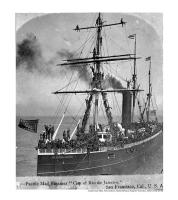
SS City of Rio de Janeiro
Recently, History.com featured an article titled “Found: San Francisco’s Deadliest Shipwreck.” They reported that the wreck of the 345-foot Pacific Mail Line passenger steamer SS City of Rio de Janeiro had been found by NOAA researchers using high-definition sonar in 287 feet of water just off the Golden Gate. When the ship ran aground in heavy fog in 1901 on a voyage from Hong Kong to San Francisco, 135 of the 220 passengers and crew aboard drowned, making it the most deadly shipwreck in San Francisco history. The ship reportedly sank in ten minutes after striking rocks on the the southern side of the Golden Gate near Fort Point. This is the first time that the shipwreck has been accurately mapped, although not necessarily the first time that it’s position has been identified.
In 1905 the Los Angeles Herald reported that divers had found the wreck. In 1931, Captain Haskell claimed to have found the ship using a two man submarine of his own design. Unfortunately, he was lost in a diving accident that year. In 1987, Gus Cafcalas, a San Francisco-area mortgage banker, said that he had discovered the wreck using sonar and photographs taken by a robot submarine. Cafcalas and his partners applied for a salvage permit but were not able to mount an expedition before the permit expired.
As reported by History.com: Recently, NOAA began its own search for the City of Rio as part of a two-year project to document the roughly 200 shipwrecks in and around the Golden Gate National Recreation Area and the Gulf of the Farallones National Marine Sanctuary. First, it partnered with sonar expert Gary Fabian, who pinpointed the mud-covered remains in 287 feet of water. (The stern had broken off and was even deeper.) NOAA did not have a submersible capable of getting down there. So it again looked outside the agency, with private companies donating a research vessel, a crew and a remotely operated vehicle equipped with high-definition 3-D sonar technology. “The ROV is bigger than a refrigerator, and it weighs a ton and a half,” Delgado explained. One day in early November, the crew lowered this behemoth off its boat and began mapping the City of Rio. It also mapped the nearby SS City of Chester, which had gone down in 1888.
Thanks to Steve Phelps for passing the article along.
